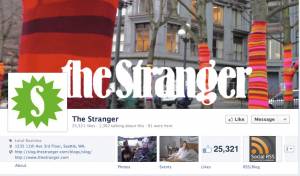Best strategies for local Facebook brand pages from radio, television and print
Everything you need to know about building a local media Facebook page, using examples from 50 of the most digitally savvy local media brands.
Having a great Facebook strategy demonstrates social media chops to the market, builds the media's Facebook audience, and provides a basis for selling contests for top dollar.
For this report we surveyed 50 Facebook pages of radio, television and newspaper companies who are digital and/or social media leaders, including five radio stations selected by RadioInk Magazine as having outstanding brand pages. How they publish and engage audiences on Facebook brand pages is broken down into eight areas:
1. Cover image
2. Cover Text
3. Profile icon
4. Updating the timeline
5. Highlighting
6. Pinning
7. Milestones on the timeline
8. Use of tabs
This report gives ideas that work for each element on your page.
Contests are the top way to monetize Facebook pages, and are addressed here, however for a complete "best practices" for selling contests, see "How to make more money from Facebook contests."
If you are just getting started or confused about rules, see also Facebook's new rules: What they mean for local media, and a complete list of contest by industry categories that will be published next week.
Here are the good, the bad and the ugly from pages we looked at, as well as Facebook rules for each of these areas:
1. Cover image
The big 851x316 pixel image of the upgraded 2012 Facebook page is all about the brand, but this can be stretched to include other priorities such as soft promotion of events associated with the brand. The image may be changed at any time, though not allowed on the image are:
- Purchase information such as prices and offers
- Contact information including including web addresss and phone number
- References to Facebook's user interface element such as "like" or share
- Calls to action, such as e-mail sign-ups or contest entries
You can still post some of these messages in the text below the image, discussed under #2.
Note to broadcast and radio sites: The number one issue with your facebook pages is that they are missing one of the following: the station number, call letters or geographic area. All of these should be visible without clicking, from the Facebook brand page. This makes it difficult for fans to see if they have the right KWET, or to find it on "the dial" if they wanted to.
Also, Facebook search is notoriously unreliable, and since the call letters could be anywhere in the counry, make sure you search by call letters, numbers and corporate name to see what comes up. A great station page we looked for and never did find was WVEE, or V-103 Atlanta. Here's the closest we came to a brand page with 88,698 fans:
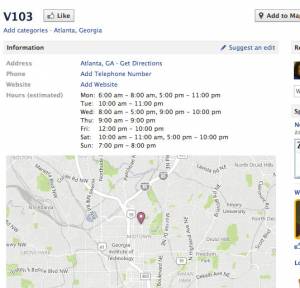
We know this is the not WVEE's real page, and with more than 88,000 fans, this media can easily afford to lose a few lost searchers. However, it does demonstrate a common problem. A number of Facebook pages in the survey did not include the name of the city anywhere without clicking. Broadcast sites without station numbers or cities was the number one easy fix that we saw in our survey of 50 top brands.
Corporate pages should use one of the tabs - or the cover image - to show affiliates.
Below is a sampling of cover strategies from the most digitally and social savvy local media brands around the country. Keep in mind that whatever constructive criticism we bring to bear, these brand pages - even as an unscientific sampling of the best of 50 digitally savvy local media companies - are the among the best in the country. Note: All links below go to Facebook pages so you can take a closer look.
a. Showcasing the personalities who are the brand to most viewers at Scripps-owned ABC15 Arizona. This is a great way to help connect super-users more closely with their favorite anchors and reporters.
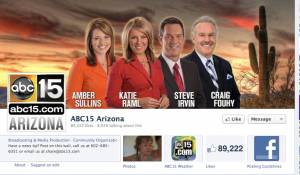
Nicely updated during peak Coyotes season:
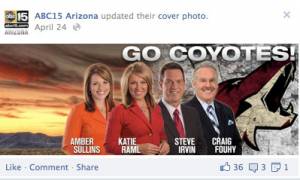
Closely related: The studio most people see when they go on air is reinforced in the cover image below at another digital leader, top rates WSB-TV Atlanta.
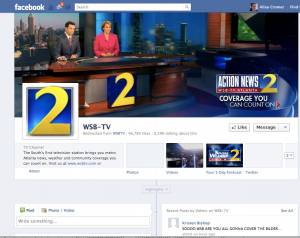
Which do you prefer? We think the first image portrays the talent to best effect. There is also a trade-off between promoting the brand, and seizing the opportunity for a compelling news shot that can be changed out daily, weekly or monthly. For broadcast sites, the reporter often is, essentially, a visual part of the story, and still-shots are an after thought. So TV and radio pages are veering towards branding images, while print pages are veering towards news photos or a co-brand with the city via iconic cityscapes photos. However... innovators are breaking the rules and a few local media are using Facebook to take fans "behind the scenes" to meet content people they usually don't see, a great strategy for connecting with super users who want more connection with columnists and dj's.
Here's another cover image from top ranking WRAL:
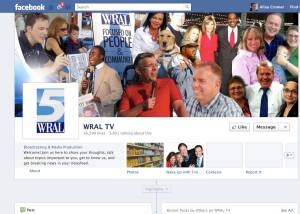
Though we're not a big fan of collages - especially ones using photo cut-outs, this does seem action-packed and less sterile than the tidy newsroom. WRAL has a engaging feel to its whole page that fits with this collage.
b. Demonstrating market dominance at ABC7 Los Angeles. This variation which associates the brand with the impressive army of breaking news vans roaming the city. Again, another great station with a top notch internet strategy. Not sure that photos of trucks is a permanent visual brand. It does look like a big coroporate station, but in all due respect to ABC7, carpet cleaners have fleets, too. Images of the news team are behind the tab, but there are no humans on this page. Missed opportunity?
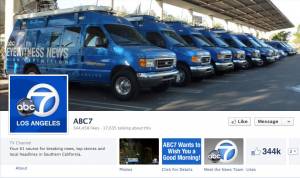
c. Promoting the top story - and pick-up rates at the Phoenix New Times. Here's the Phoenix New Times, a flagship property of Village Voice Media Group, showcasing its weekly cover story on its brand page:
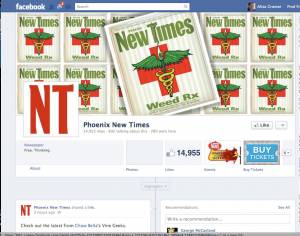
This wasn't their most compelling cover image, but the strategy works on many levels when a publication such as a weekly, tabloid or magazine, and has a magazine-style cover; it ties in with images on news boxes and racks throughout the area, driving pick-up and getting the top story shared and talked about more often. Too bad the Facebook layout is horizontal while covers are vertical.
d. Co-branding with the city via an iconic cityscape at the Dallas Morning News. Many local print media have settled for iconic cityscapes, including the Pittsburgh Post-Gazette and the Dallas Morning News (below). There is a subliminal message here that the media is presenting the city's own page, and story. The city is, essentially, the brand.
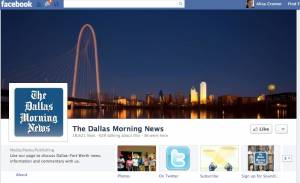
e. Creating a memorable graphic at KPIG. Many radio site use graphic images including this memorable one from KPig, based in Santa Cruz. We love this image and they do change it out from time to time. We can see variations (like the Google logo, but, perhaps not daily) to fit the season, top news stories and so on, that is, if the station has a budget to produce new graphics that correspond with hot topics and seasonal issues. Pig going to the Rock Concert or Blues Festival? The danger here is that the budget for changing graphics is cut or the "Pig" becomes overly redundant with the profile picture. Where is this market anyway... am I still in Santa Cruz or is this a national brand? What is the station number? What kind of music?
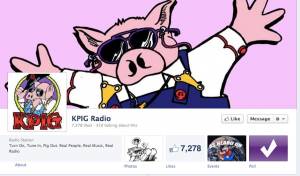
f. Concert photos to promote the station's core franchise
A few radio stations with huge fan counts (thanks to RadioInk for identifying these industry leaders) also had photos as the cover image. Here's one of our favorite fan pages at Clear Channel's Kiss 108:
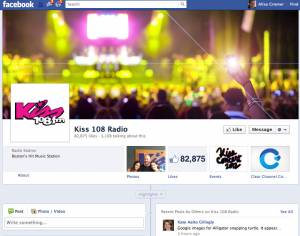
We'll be referring back to this brand in the discussion of keeping an entertaining tone and content for Facebook updates - they are masters at humor and tone. Our only observation - there are KISS stations everyhere. Where am I here? If I don't know 108 from 106, I may be on the wrong Facebook page.
g. "Behind the scenes" photo at WTOP radio news
What a great start to engage this innovative station's most loyal fans than giving them a peak at the Wizard of Oz.
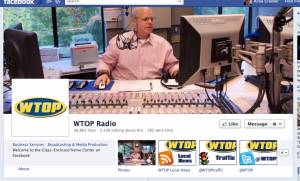
h. The Big Bash on the cover image at B-93
Every year, B-93 throws a huge concert as its flagship event. It uses the photo from last year's event to build enthusiasm for the next one. We're just guessing that demo that sees this image is going to want to be there, and a picture conveys the event in a way that mere audio cannot.
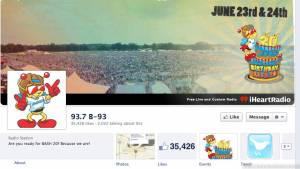
i. Showing photojournalism chops at the New York Times.
For news sites the cover photo is an opportunity to showcase great photo journalism. Here is an example from the NYTimes site:
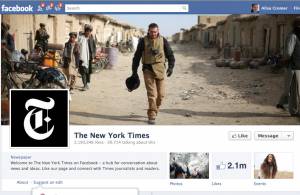
One note about the Times - when they get a great shot like this, they don't change it out every day. It stands for their brand. This is not about headline news photos, but that on an ongoing basis they provide the most memorable coverage of the world's most compelling news. This photo, is, essentially, a mission statement.
To summarize: The medium, mission and market positioning all determine the best choice for the cover image. Here's a list of strategies from our sample:
*Photo journalism for high emotional impact and to establish journalistic chops. This makes more sense for news sites that are less entertainment-oriented.
*User-generated photo contests (selected by an editor) to generate compelling local cover images, incorporate users and reflect the local community.
*Replication of the cover to redistribute the most important story for that week, promoting pickup and conversations.
*Photos that portray market dominance and a recognizeable external brand; fleets of news trucks, lines of newsracks, help position the company, but can look sterile.
*Promoting local television personalities who are central to viewers connection with the station.
*Playing with graphic images to create a unique visual brands for a younger market, especially suited for radio. Careful about duplicating the image in the profile picture, or leaving a static graphic in place too long.
*Photos of a young, stylish demographic - style shots and concert photos.
*Behind the scenes photos inside the newsroom to connect with super-users and create the fan page as an "in the know" area.
*Promoting a major upcoming event associated with the brand.
One note here, in most cases we'd like to see more creativity and perhaps incorporating a few of these ideas over the course of a year. This is a brand page, but there are numerous ways to mix it up so that Facebook is a little surprising and different from the web site. Even a simple headline such as the one used by ABC15 Arizona (think along the lines of "Go bears," "Don't forget to vote", etc. ) can be posted to the image to reflect current events. We especially like the "behind the scenes" shot at WTOP. Fans want to communicate with Dj's and writers as well as with anchors.
2.Text lines below the cover image
Facebook allows three lines of text under the cover image - but not on it - to describe your company. Since people may not click to see the full profile, some sites are putting more contact information in these lines instead of behind them, such as the phone number, URL, or address, and request for a like or a news tip.
The best text statements in the sample fall into two categories, a brief mission or positioning statement and/or a call to action. Here are some examples from our survey of pages:
Mission and positioning statements
ABC7: Your number 1 source for breaking news, top stories and local headlines in Southern California
New York Times: Welcome to the New York Times on Facebook - a hub for conversation about news and ideas. Like our page and connect with Times journalists and readers.
Dallas Morning News: Like our page to discuss Dallas-Fort worth news, information and commentary with us
WRAL: Welcome. Join us here to share your thoughts, talk about topics important to you, get to know us and get breaking news in your news feed.
ABC15: Have a news tip? Post to this wall, call us at 602-xxx-xxxx or email share@abc15
B-93: Are you ready for bash 20, because we are!
Best practice is to have on hand both succinct mission statement and an invitation to engage. Most local media in this sample did a nice job of "boiling down" a central positioning statement. However, a few still run on and on... and off the page such as, and so as not to name names: "We are the primary source of news, information and community for the area bounded by Pacipsky, Durado and ...."
Note, too, that just as the cover image can be changed so can this text, as media priorities and initiatives evolve. During bad weather, news tips, photos or videos may be important. During a fan drive, "liking" will be top priority, etc.
3. Profile picture/icon
The key to the profile picture/icon is that it need to be built to be exactly 180x180. This image will also appear in much smaller in icson thumbnails on updates, so it's critical that is is designed specifically for this use. Almost all logos are horizontal and do not fit, resulting in cramped or worse, cut off type:
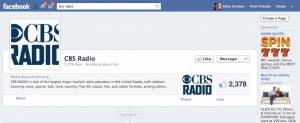
The above is a typical example of a corporate page floating out there in Facebook land - we've seen many of them like this for local media companies, so be sure to search Facebook for your company's name to see what might be out there. You may be surprised. CBS Radio News has a better page and icon:
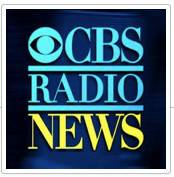
Keep in mind your clients also have this problem, and need help (hence selling Facebook services including great designs and strategies may be a natural outcome of your own evolving Facebook prowess). Here's an example of a thoroughly bungled page icon, from a great company that has managed to build a small following in spite of itself.
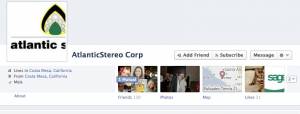
Our favorite icons have a separate Facbook savvy feel. Here's one from The Stranger, whose design sensibility strikes Savagely:
And the always classy Tennessean combines a simple icon with iconic news photos that change daily (note how their three lines guides users to the web site, twitter and commenting):
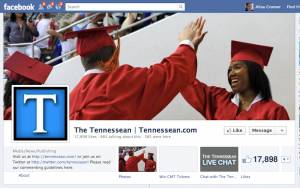
And what would you do if you were the Washington Post Company? Check it out:
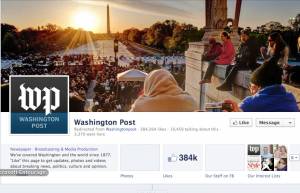
The Post's text reads: "We've covered Washington and the world since 1877. "Like" this page to get updates, photos and videos about breaking news, politics, culture and opinion."
Do they really need to repeat the Washington Post under the profile photo... right next to Washington Post in the title? Probably not. You can't read it anyway in the smaller thumbnail. However television and radio stations should include the geographic area of coverage in the profile icon if it is not on the coverage image or title. ABC15 puts "Arizona" in its profile image so it shows up on the page somewhere.
4. High-lighted posts make external events bigger and more important.
When high-lighted, posts cross the two column line known as the "spine." Posts can be highlighted simply by clicking on the * (star) icon on any post.
Highlights can be used for important breaking news, major events, or contests - just like weighting a story by giving it more space and images before the jump. We don't see local media companies using this feature. Here's an example from the Tennessean:
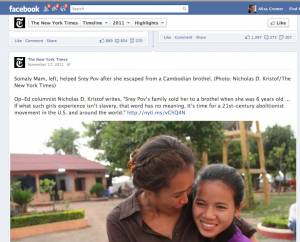
What is your strategy for highlighting a promotion? A news event? As long as updates and highlights have the right mix and cadence the page will be useful instead of annoying to fans.
5. Updating strategies
The updating strategy includes tone, voice, content mix and cadence (how many, how often).
The biggest different between fans using Facebook and fans on the web site is that on Facebook they can initiate conversations, where as on the web site they can only comment. We like WTOP's "Write a recommendation" as the top feed on Facebook, viewers come up with all kinds of ideas for the station, and provide a different kind of content.
Also, consider that every post appears on your fans' wall. It needs to be a little more personal and engaging.
The jury is still out, however, on the ideal mix of commercial and editorial content, and number of posts.
The Quad-City Times for example, posts a respectfully conservative four times a day; digital director Tim D'Avis, who initiated sales of Facebook services for Lee company-wide, has the theory "We need to add value (to the news) if we are going to comment in the stream" on someonelse's page. But television pages in the same market post up to 30 times a day.
News sites typically post a news item, with an engaging question. The super-savvy, if sometimes a tad Facebooky, updates we saw come from Scripps-owned ABC15 Arizona. Since they also sell Facebook services, this is not really a surprise. The variety of mechanisms to engage readers, and add perspecitive to content, include these tactics:
- Contreversial story questions
These start out with a "do you think" approach:
"Is award a harmless joke or hurtful to an eight year old student?" above the link to the story "Arizona girl's 'Catastrophe Award' for most homework excuses goes viral"
- Personal experiences or "takes"
These ask readers to share something about themselves that relates to the story:
"When was the last time you traveled with your pet?" above the headline, "GoodMorning America goes over everything you need to think about when traveling with your pet"
"Would you have a tattoo removed to land a job" against a story on a doctor seeing more patients removing tattos to help gain employement.
- Fill in the ________________.
Instead of always having open ended questions, fill in the blank is another way to mix-it-up, and keep answers concrete and interesting. Examples:
"I'de pay ________________ to find my missing pet" to highlight a story "ABC is talking to a woman paying a huge ammount to find her missing pet, tonight on ABC15 at 10 p.m.
"Sale or not I always by__________________at the grocery store" with a promo for ABC's best grocery store deals.
"Most valuable player on the Coyotes team is_______________" against the latest update on a Coyotes ice hockey team player suspension.
- Anytime feel-good questions
"Happy Monday. What made you smile over the weekend?"
"Happy Friday. Pick one thing you enjoyed doing this week."
"Good morning. Post the best meal you've had so far this week."
Etc.
- Missing people and wanted people
"Have you seen this woman?"
"Day four that Angelina has been missing. Have you seen her?"
- Sports
Sports engages viewers so fanatically that it deserves its on engagement strategy. Here are a couple from the social media masters over at ABC15:
"Coyotes are down by two share this post to ROOT THEM ON!"
"Will the Coyotes win tonight versus the Nashville predators" with multiple choice answers
- Contest related personal experience questions
"What is one thing you plan to do to celebrate Mother's Day" with a contest promo for Mother's Day. Check this one out here:
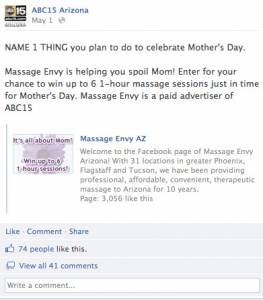
- Solitication for and images from photo galleries
There are innumerable reasons to asks for photos, and they make the page that much better.
For non-news radio stations, entertainment is the greater part of the posting equation. Fans want information about the artists played on the station, celebrity gossip and entertaining or humorous tidbits they can share with friends. In RadioInk Magazine, Jacob Carty, of Kiss 106.1 Dallas said their team cultivates a mix of "music, gossip and weird news - the weirder the better" as the secret to higher engagment. Our favorite Facebook posts were from Clear Channel's Romeo at Kiss108. Here are a few samples:
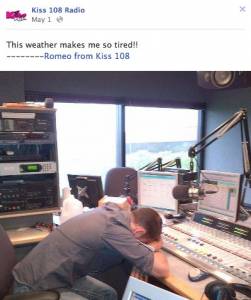
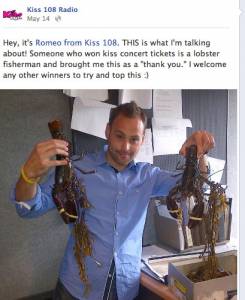
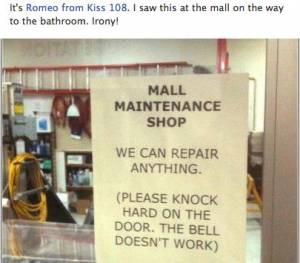
Authentic, personal and very funny.
And then there are events that can make radio visual. Posting live from B-93's June Concert brought in 1.4 million page views and 53,000 unique visitors in four days. Or the WTOP reporter taking the audience on her journey preparing for a marathon to celebrate an "0" birthday, complete with Facebook links to videos of selecting a running shoe, etc. Keep in mind, this is a radio station - that has created a blog, with video and Facebook updates for one of it's staff members.
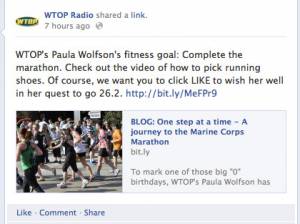
6. Milestones on timelines highlight internal events.
Like highlights, milestones cross the spine to create a double column post - and tell the story of the media company. The difference between highlights and milestones is that only milestons also appear in the timeline under dates. Use them for major events within organization such as new product launches, or achieving numbers (fans, deals, years in business, etc.). Many local media companies have done a great job of back-dating their timeline to tell the story of their company, interspersed with key news events in the story of their community.
The Washington Post and the Nytimes.com are both good examples of how to back-fill timeline posts to create a mini-bio of thir companies and most important news moments.
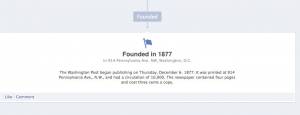
7. Pin a post to move it to the top of the profile.
This is another under-utilized feature of the new Facebook pages and especially important as a selling feature for contests or as an upsell to advertising major events. Updates that are pinned move to the top of the page, just under the cover photo and tabs - and stay there for seven days.
To pin a post, click on the pencil icon an any post. Pins will be moved - they will disappear as highlighted posts - and stay up for seven days. They can also be removed. And there can only be one pinned post at a time.
What to pin versus what to highlight? Pin things that are on-going and will be important for seven days. So marketing experts recommend media "pin" important, ongoing promotions, or ongoing coverage of an important news story such as a crisis or election. Significant updates in the news story or contest - can be highlighted. Make sure you include the "pin" in the sales package if selling a contest to an advertiser.Find more tips on selling Facebook contests here. Or include a "Pin" in the sales package to promote a major event such as a sports game, film festival or concert.
6. Tabs
The most creative use of Facebook pages is in customizing tabs (under the cover image) where where contests and promotions entry forms are now accessed. Since contests are the best revenue producer for Facebook pages, creating custom contests on the tabs is a core competency.
Facebook no longer allows like-gating contests directly - or entrance requirements that include wall posts, sharing, commenting or any other use of a Facebook native app. It does allow like-gating via a third party app (such as Shoutlet or Second Street) behind the tab, however.
Here's a quick break down of how the tabs work:
Facebook moved the tabs from the left rail to prominent positions under the cover image. From a strictly ROI standoing, best practice is to place important promotions in the first three tabs - a prominent and salable position.
But not so fast...
The "Photos" tab remains permanently in the first (top left) position (not a bad thing since studies show that photos have the highest consumption overall). And most media companies prefer to leave the "Likebox" - that gives the number of fans - on top as well, a kind of "social proof" of audience.
Since only four of the total of 12 available tabs are visible on the home page, that leaves only two always visible tabs for promotions or anything else. The most advanced compnies companies are running 5 to 7 sold contests concurrently. Not all of these need to be promoted on tabs on the media page, they can also be placed on the advertiser page and promoted by traditional advertising, as well as some email and Facebook posts and pins. However, you can see how developing contests and other initiatives can put competitive pressure on who gets the best tabs.
One solution a few companies used is to move the LikeBox to the second or third evel to make room, for more contests or other functions. We see no reason not to move the LikeBox down, as the information is already duplicated in the two lines under the title of the page for anyone who wants to know.
Also important is the image and title of the tab thumbnail. A title, "Win a car" with a picture of a car is better than a generic icon with the title "contests." If you don't know what you are going to win you are less likely to click.
Of the super socially savvy companies in the sample, about 30% of the Facebook brand pages had a broken, empty or only partially utilized tab on their page, and load times are often slow (I accidently took some screen shots before the pages had loaded several times). So clearly tabs is an evolving area where a lot of experimentation is underway.
The best way to create a tab strategies is to start with top row that always shows, then what's underneath. Many second and third tier tabs were once on top, then swapped as priorities changed.
For a simple page with no custom apps/behind the tab, most local media sampled have chosen three out of these typical options: Likebox, Twitter, Welcome page (with additional company information), Events, RSSFeeds, Contests, Meet the Press, Weather, Posting Guidelines.
We consider the Welcome Page and Posting Guidelines to be "fillers" and recommend pushing them down, unless there is not other content. Events was also underutilized in most cases. If you have just one big event, create a tab for it, but don't put it under "Events" which is misleading, since people will be expecting several.
Local media we sample either arranged the tabs in order of importance, or grouped some like-tabs - such as photos and videos, or contests - together. The more content in the tabs, more more likely that the Likebox, Welcome, and Posting Guidelines were pushed down.
To get a sense of tab strategies, here's a quick glance through some tabs at some of the most savvy broadcast companies:
ABC15 in Phoenix: Photos, Weather, LikeBox, Posting Guidelines
WSBTV: Photos, Videos, Weather, Twitter; second level: Posting guidelines, Likes
WRAL: Photos, WakeUp With Friends, Contest, Chat; Second level: Weather, Likebox, Videos, Events; Third level: Report it, Games, Notes (news), Blogs
ABC7 in Los Angeles: Photos, ABC Wants to wish you good morning (a contest), Meet the news, Likebox; second level: Events (schedule broadcasts), videos
CBSRadioNews: Photos, LikeBox, Events, Twitter
Affiliate map, Welcome box, Audio, iPhone app
KSOK: Arkansas city: Photo, Like box, Contact (email box), events
second tier: Video
KPIG: Santa Cruz, Ca: Photos, Like box, Events, Poll (from tradable Bits, too slow and didn't work well).
WTOP: Photos, news, traffic, twitter; second tier: Likes, Map, Events, Video; A few comments on these tabs:
Notes on tab strategies: KISSFM106 in Dallas has a "Listen Live" tab, a great idea to allow fans to listen while they are interacting with the page.
CBSRadioNews is a national brand, so its affiliate map on the tab is very important. It also uses Events, which is a native app, to post links to news coverage. The links point to CBSRadioNews podcasts on Radio.com. The name of the links don't always match the podcasts, but this gives you an idea of creative ways to use the native apps. The events tab typically promotes the media's advertisers and promotional events; and less often, community events in general.
Some notable efforts here include WRAL's use of all 12 pages, including a "ReportIt" tab to collect news tips. Here's there full set of tabs; and note that this company did push LikeBox down to the second level in favor of a "Wake up with..." (whoops, needs a shorter caption), contests and chat. It was the only station we looked at that used all 12 tabs; although thumb nail images and titles could be streamlined.
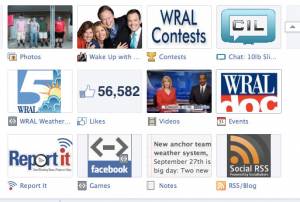
Also of note: "ABC Wants to Wish You Good Morning" is a "Fan of the day" contest, which viewers enter to be acknowledged in both the morning broadcast and on the timeline update. Fan of the day contests are hugely popular on broadcast sites and we think they can also work for radio and even print companies, though clearly, television has the most cache. For a full "how to" case study here.
Also, "Meet the NewsCasters" and "Wake Up with Friends" are both promotions for the station pages of on-air personalities. Here's a look at the funnel for "Meet the News Team" on the third tab.
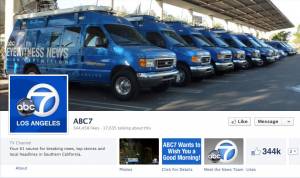
Clicking on the tab takes you to these next two pages, starting the news team:
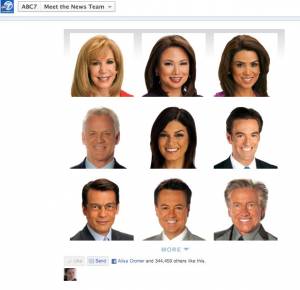
Clicking on a photo takes you to the profile page:
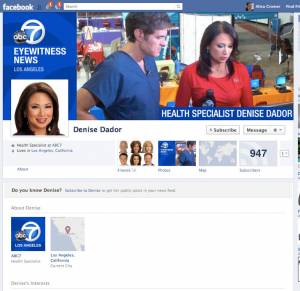

Like "Fan of the Day," "Meet the Press" tabs can also work for radio and print, especially with popular columnists, sports and political reporters. We think this could give "fanning" the page the feel of being closer to the people writing the news, who are already Twittering and responding to readers.
One especially effective line up of tabs for radio news is from WTOP: Photos, News, Traffic, Twitter, Events, Videos. If the WTOP logos were reduced or eliminated, there would be a clear, consistent set of buttons.
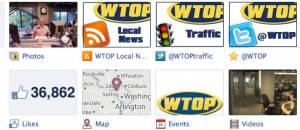
One of the best things about WTOP events tab is that it has numerous events there. Most sites do not have a consistent events strategy - no events or one event, or - and we kid you not - only events that have already happened - is not what the user is going to expect. So it should be a selection of the best events in the community, or the upcoming schedule of media promotions.
Print pages in the sample had a slightly different focus and set of innovations for tabs: More obits and less weather, for example, and some different interesting new initiatives. These are "at the edges" of Facebook devleopment so no clear trends have emerged beyond the obvious value of contesting which is a clear revenue generator:
*Sign-up to sound off (Dallas Morning News) requests viewers not just to leave a news tip (see the "ReportIt" tab from WRAL above), but also to sign-up for email solicitation to give their, publishable, opinions.
*Marketplace coupons are featured on the "Get it" Quad-City Times brand tab, currently being upgraded to a Shoutlet app. Similarily, Daily Deals are a tab on Pittsburgh Post-gazette's page (most local media have separate brand pages for deals).
*Five contests running simultaneously on five tabs (three current and on top, and two showing results in the second tier) at the Denver Post. This pushed everything else off the top tab bar, except for the contests. Great work selling and promoting concurrent contests (Quad-City Times also has seven contests running concurrently, though most are promoted on the advertisers own Facebook page).
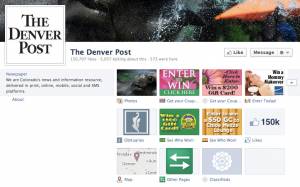
*Selling subscriptions and ticketing directly on line (Dallas Morning News and New Times respectively). This was the first site we saw selling subscriptions via Facebook - especially digital subscription. Facebook fans include "super-users" that want to engage with the brand - so it is a great platform for upselling content packages. On the other hand, how many fans are not already subscribers? Here is the basic promotion:
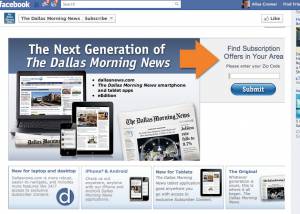
This page links to an order taking page, without leaving Facebook:
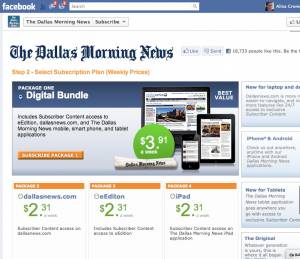
*Selling the tab/app to an advertiser, not for a contest, but as part of the advertising promotion (Phoenix New Times). This is worth looking at, basically a film promotion with an embedded video clip took up one of the tabs. We don't know the sales strategy here, however, with a stong movie, theater, and/or events franchise, keeping a tab open for movie trailers or opening nights be a great competitive advantage. Here is the a link to a really great movie trailer. A still is below.
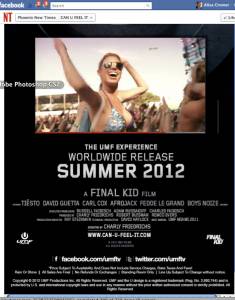
*Live chats (The Tennessean). Prolife or ProChoice is just one chat, with an app provided by cover-it live at this link, also see below:
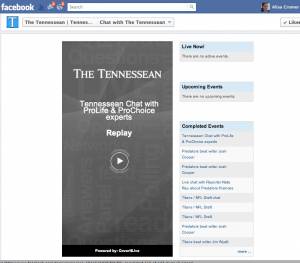
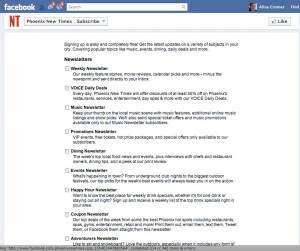
*Fan thank you video. When 10,000 fans were reached, 50 names of fans were drawn at random and made into a fun video (Palm Beach Post). The link to the video here. Screenshots of the page and video are below ... it's pretty cute.
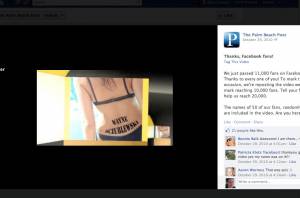
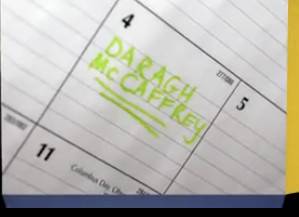
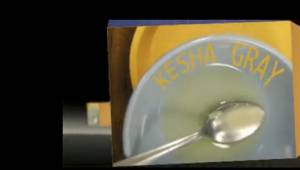
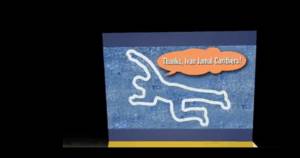
Fan reaction when they see their name in the video is priceless. Ok, so the "video" is really just images set to rock-and-roll music. But at the expense of setting a team of designers and maybe a photographer loose on this to produce 50 creative images, this video got share a lot. A fun project.
Here are the tab lay-outs of a few of the best pages in the sample so you can see what these companies think is most important:
Tennessean - Photo, Like-to-Win (contest), LIve Chat, LikeBox; second level: Twitter, Events, Map
Pittsburgh Post-Gazette: Photo, Likebox, Twitter, Rss blog; second tier: Used Cars, Deaily Deal, Mobile, Welcome page
Palm Beach Post: Photo, Like Box, Twitter, Map; second level: Welcome page, RSS feed, Events, Video
Dallas Morning News: Photos, Twitter, Subscribe, Sign-up to sound-off; second level: Likes, Obits, Map
Denver Post: Photo, Contest, Contest, Contest; Second level: obits, See Who Won, See Who Won, Like Box
Phoenix New Times: Photos, Likes, Events, Buy Tickets; Tier two: Twitter, Map, Movie promo, Newsletters; Tier three: Videos, YouTube, Photos, Welcome page
Show me the money
There's a lot of cool stuff do to with social media, and there is no doubt that it retains your core audience and drives traffic. Incremental sales of posts and pins are gravy in adding value to big campaigns. However, if you want to ROI social media and justify your team and efforts it's all about contests.
There are two key sources of revenues from contests:
a. Building the email or opt-in audience for deals and other targeted sales. These include direct sales on e-newsletters, and sponsorships of text-alerts, however deals is the most profitable overall. Since emails directly drive deal revenue, contests to build email opt-in lists has a quantifiable finanicial impact.
b. Selling contests to advertisers. Contests sales to advertisers are also driving significant revenues: $500 to $5000 in very small markets per contest; $5000 to $15,000 in mid-sized markets and on up to $20,000 per contest in larger markets, including the media buy. It's a hot category with lots of revenue potential and worth investing in.
When selling contests keep in mind that you can sell the contest on the advertisers page, or dual fan gate, and charge for this service. It's fairly easy to build a custom page for your advertisers too, using a tool such as SocialMediaMadesimple. Some media, such as Scripps, Lee, and of course the Denver Post shown above, are running multiple contest both for clients and as audience builders - up to seven at one time.
To review best practices for contests:
*Use a third party application on the tab page
*Pin the contest to the top of the page
*Use the top tabs to promote the contest
*Promote heavily with multi-media - including email, print/onair and online. Show them visually in the sales materials.
*Promote to a media.com/facebook page, and redirect to the tab page
*Include in the updating schedule
*The most valuable leads for advertisers are people who are interested in their product, so a simple sweepstakes giving away what they are already selling can be a home run. Example: A plastic surgeon giving away a $2000 procedure may collect hundreds of leads from people who are interested in that specific procedure.
*Run the contest on the advertisers page. This often requires administrative access; so consider selling contest management and page management as a service.
We still talk to media executives who are under the impression that they can't like-gate on the new Facebook platform. Not so. Photo downloads, email capture, dual fan-gating, and all the other tricks of the trade are still available using a third party app behind these tabs. The catch is that since advertising Facebook/ABC7 will no longer take you to the contest page, best practice is to reverse the order and promote to ABC7/Facebook, with a redirect to the contest page, which has a really, really long URL. There is no other allowable way to shorten this link. To review a the new rules in a simplified version go to Facebook's new rules: What they mean for local media.
See also a quick chect list of what to do right in How to make more money from Facebook contests.
Summary and takeaways
Looking at a sampling of 50 top media Facebook brand pages is a snapshot of the current state of social media use and shows what kinds of develop are underway. Here are the top takeaways:
*Consider the cover image in the context of brand strategy - its mission and position in the market.
* Some uses of the cover image include: Photo "winner of the week" from user generated photos, cover of the week, profiling personalities associated with the brand, creating brand graphics, promoting a flagship event, photojournalism and behind the scenes images.
*Design the profile picture for exactly 180x180, but also to work much smaller.
*Make sure the geographic area, if it is not in the media's name (Ie Denver Post), and in the case of broadcast, call letters and station number, are all on the page or profile picture. As one reporter pointed out, "there are ABC7's everywhere."
*Check the Facebook search for your company to see what shows up.
*Best practice for text under the cover image is a mission/positioning statement plus an invitation to engage or call to action. Guidelines specifically prohibit contest promotion, but not general requests to "like," leave news tips, or watch a broadcast.
*Put contests on top tab bar
*Move the LikeBox to slot four in the tab bar, or if three contests are sold, or consider moving it to the next tier as the tab strategy develops. The number of fans is already in the line under the title.
*To promote contests, advertise a media/Facebook URL on your own media site with a redirect to avoid the overly long URL's on Facebook's inside pages.
*Content and cadence updating strategies are core skills for local media companies, which can be resold as Facebook services to SMB's, along with custom pages and contesting.
*Make sure that top management is acquainted with new social media rules.
*Data collection strategies take place in apps behind tabs, including: Collecting emails via a simple "contact us," collecting news tips, Sign-up to Sound off, Sign-up for a long list of email newsletters, and contests.
*Popular audience building contests for broadcast include "Fan of the Day" contests.
*Besides contesting, commercial uses of tabs include selling the tab itself to an advertiser (in this case for movie trailers); posting used car classifieds, posting obituaries, Daily Deals, Marketplace coupons (coupons from directory sites). Social-commerce experiments include selling tickets and subscriptions on tab pages.
*"Meet the press" tabs that point to media personality station pages engage readers with anchors, dj's and columnists they want to communicate with.
*Remember updates will appear on your fan's own pages, so ask a question, and keep them interesting. Look for contreversial news, top stories, and news of the wierd. For entertainment sites, include information on artists.
Many thanks to all the experts who contributed to the knowledge base of this report. They include Brian Page, of E.W. Scripps; Tim D'Avis, Digital Director of Lee-owned Quad-City Times; Second Street Media and RadioInk Magazine. Any errors belong to LocalMediaInsider alone.

The author, Alisa Cromer is publisher of a variety of online media, including LocalMediaInsider and MediaExecsTech, developed while on a fellowship with the Reynolds Journalism Institute and which has evolved into a leading marketing company for media technology start-ups. In 2017 she founded Worldstir.com, an online magazine, to showcases perspectives from around the world on new topic each month, translated from and to the top five languages in the world.


